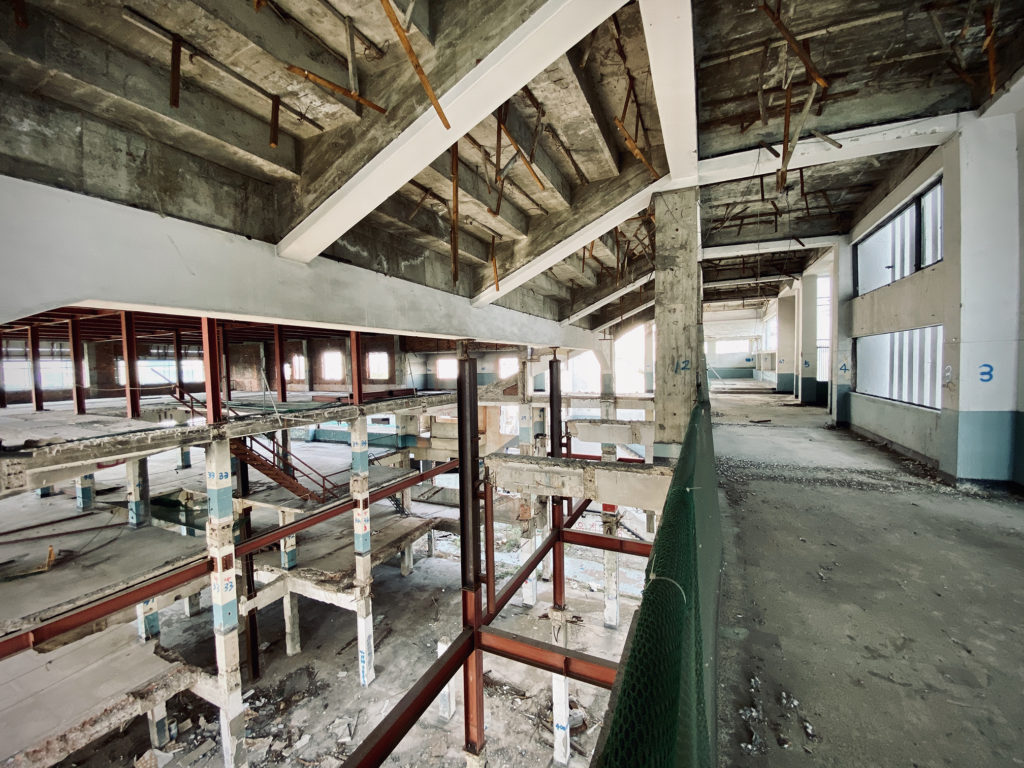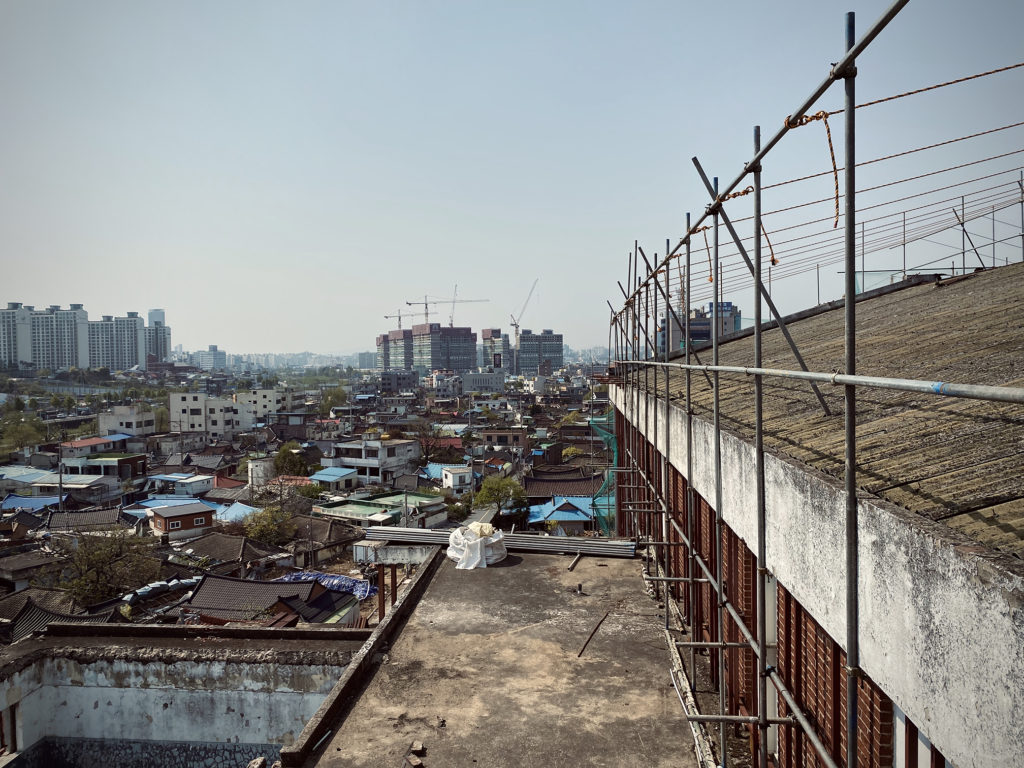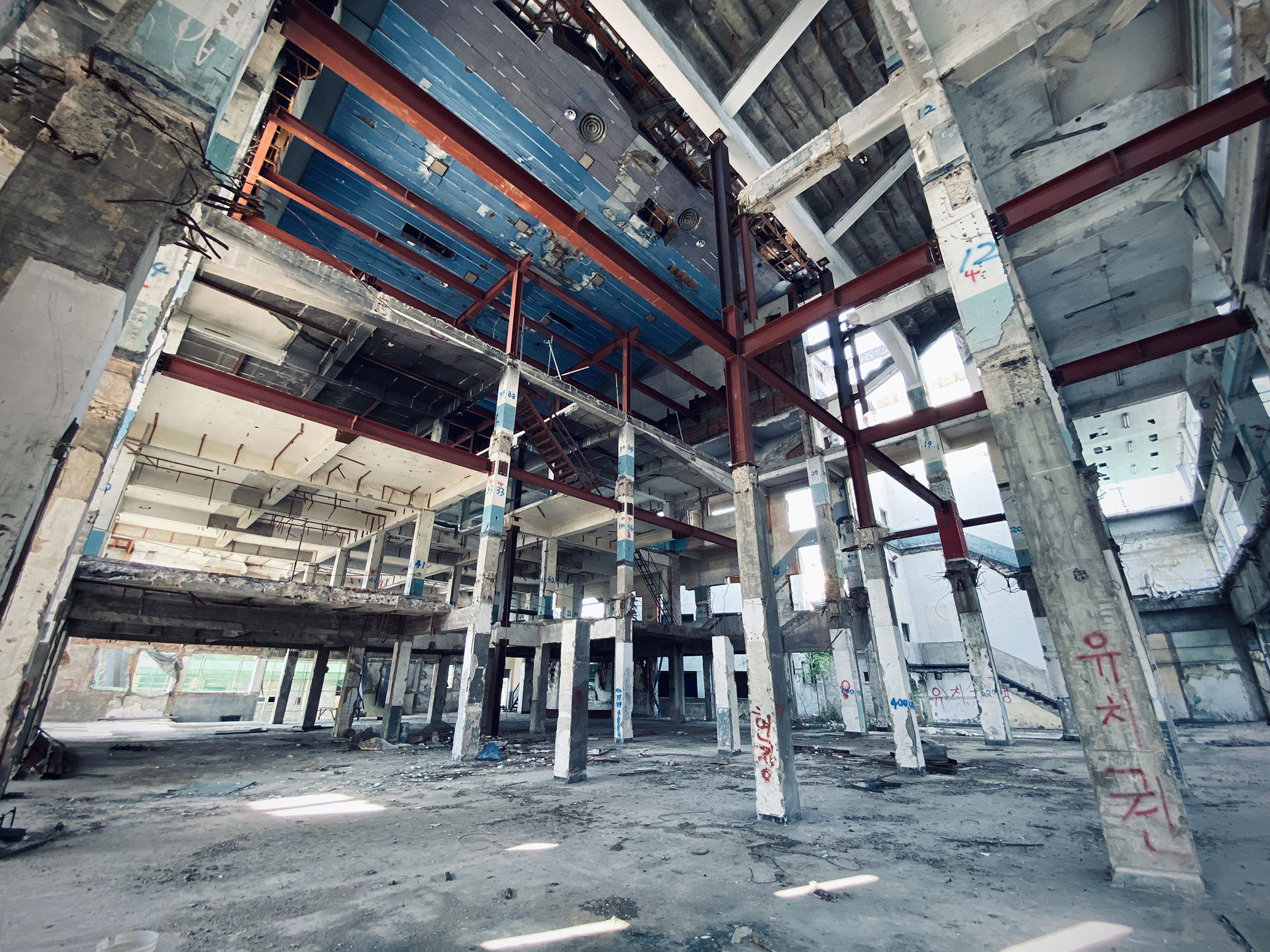The Asia Theater, Once a Battleground in the “Trot War,” Is No More
Written and photographed by Isaiah Winters.
Now reduced to little more than a stack of exposed beams and buttresses, the old Asia Theater (아세아 극장) in Yu-dong doesn’t impress; however, after having done a little online sleuthing, I hope to bring the condemned theater back to life for one final show. Basically, the single-screen cinema dates back to 1966 and included a shopping mall on the first floor, a wedding hall on the second, and, at some point, a “cabaret” dance hall somewhere within. At its peak, the venue screened two films regularly, hosted popular singers every few months, and married people off in style.[1] As it turns out, it was also a battleground in one of the greatest music rivalries in Korean history – what I call the great “Trot War.”

The Belligerents
The Asia Theater was unique in that it had an unusually high ceiling that allowed it to double as a concert hall. Among the biggest acts to perform there was the Busan-born “emperor of trot” Na Hoon-a, whose music career debuted the same year as the theater. The son of a sailor, trot’s “emperor” is probably best remembered for dropping trou on live TV back in 2008 to prove to the press that a yakuza member did not in fact castrate him for having a dalliance with one of said gangster’s favorite actresses.[2] To set the stage for our great “Trot War,” let’s put Na in the red corner.
Mokpo native Nam Jin is another famous trot singer who performed at the Asia Theater during its crescendo. Debuting just a year earlier, Nam, the well-off son of a national assembly member who also owned the Mokpo Ilbo, had a flashier Elvis vibe compared to the “emperor’s” low-key masculine vibe. In our battle of the port city crooners, we’ll put Nam in the electric blue corner. Nam and Na’s intense rivalry would begin in the late 1960s, span the 1970s,[3] and then forever linger in the annals of music infamy once things died out. When the great “Trot War” was at its apex, bedlam between fan factions, a deranged bottle attack, and a case of arson made it arguably the most interesting conflict in Korean music history, though set to the worst music.
The Battles
Apart from the two performers’ cutthroat musical competition, their fans were also known to brawl and hurl insults at each other based on the opposing singer’s appearance. To the tan, bold-featured Na and his supporters, rival fans would shout “Cattle thief, get out!” (소도둑놈 저리가라!)[4] Apparently, Na earned the nickname “cattle thief” by looking like the more nefarious of the two singers, like a hardened rustler. In retaliation, Na’s supporters launched verbal salvos of their own targeting Nam’s visage. Considered the paler, softer, more porcine-looking soloist, Nam got stuck with the curt sobriquet dwaeji (돼지, pig). Not lacking in imagination, Nam’s detractors fleshed this insult out into a chant akin to “Stop that slit-throated pig squeal!” (돼지 멱따는 소리 그만해라!)[5]

In 1973, the spat reached a fever pitch when Na was attacked on stage while singing “Solitude of a Teahouse.” Wielding a broken cider bottle, the attacker managed to gash Na’s left cheek so badly that over 70 stiches were required to close the wound. A maelstrom of press speculation ensued, including accusations that rival performer Nam put the attacker up to the assault. The assailant, Kim Ung-cheol, claimed to know Nam during the subsequent police interrogation, but police were doubtful and placed Kim under arrest.
Kim had indeed met Nam before, but the encounter was anything but cordial. Recalling the incident, Nam said he woke up one day to the sight of Kim at his home holding a weapon and asking for money not to attack his rival Na. Although Nam later admitted to being afraid at that moment, he’d also recently served in the Vietnam War and so wasn’t the kind of guy to back down to extortionists. Ultimately, he refused, berated Kim, and that was the end of it. It turns out that Kim’s threat wasn’t idle, as he would indeed go on to attack Na a few days later. In response to the fracas, the prosecutor’s office in Seoul interviewed Nam but soon cleared him of any wrongdoing.
Unfortunately, Kim would darken Nam’s door once again in 1980, setting fire to the performer’s hometown residence in Mokpo and incinerating the only pictures the singer had of his late grandparents. Although clearly mentally unstable, Kim was nevertheless capable. A former member of the Special Forces, Kim was the kind of soldier who was sent on covert missions into North Korea, so he must have been a pretty tough guy. Apparently, threatening entertainers for money was one of his regular hustles as a civilian, as he would eventually do this to at least three famous performers. Despite all this, Nam, a devout Christian, seemed to forgive Kim in later interviews.[6]

The Aftermath
As trot music gave way to newer genres like pop, the great “Trot War” seemed to fizzle out. Both Na Hoon-a and Nam Jin went on to have long, successful careers and are still active today; whether or not their rivalry came from any real animosity between them is doubtful. It was more likely a manufactured feud egged on by the media and record labels, which is common across the music industry worldwide. In this regard, both singers and their promoters came out on top by war’s end. Whatever fate befell Kim Ung-cheol is a bit of a mystery, though Nam once mentioned in an interview that after prison, Kim went on to marry a lady from church and become a father.
The only clear loser of the great “Trot War” appears to be the Asia Theater, which is currently undergoing demolition along with the rest of its surroundings in Yu-dong. Despite its zenith hosting entertainers like Na and Nam, not to mention other big names like Ha Chun-hwa and the “Bunny Girls,” once the nearby bus terminals moved to where the Gwangcheon Terminal is today, with major wedding halls following suit, the Asia Theater’s wedding hall business took a dive. The deathblow seems to have come around the year 2000 when Gwangju got its first multiplex theater, Enter Cinema, which set up shop just a few blocks away. (See issue #212 of the Gwangju News for more on that.)

By the time I arrived in Gwangju ten years later, the Asia Theater had long been gutted for a renovation effort that never materialized. A lien was placed on the property and then nothing much happened in the area until evictions began in the last year ahead of redevelopment. Now it sits hidden behind sheet metal, tarp, and scaffolding awaiting the wrecking crew. It’s a sad curtain call for one of the entertainment bedrocks of bygone Gwangju and battlegrounds in the great “Trot War.”
Sources
[1] Lee, G. (2008, July 25). [영화가 흐르던 자리] <5> 아세아극장, 광주드림 [Gwangju Dream]. http://www.gjdream.com/v2/news/view.html?uid=388094&news_type=207&page=2&paper_day=20080725&code_M=2&list_type=2
[2] Kim, J., & Lee, J. (2008, January 25). South Korea holds breath as singer drops trousers. Reuters. https://www.reuters.com/article/us-korea-singer-pants/south-korea-holds-breath-as-singer-drops-trousers-idUSSEO9854720080125
[3] Ko, D. (2016, April 28). Divorcing singer reappears after 8-year hiatus. The Korea Times. http://www.koreatimes.co.kr/www/news/people/2016/04/178_203620.html
[4] Hong, J. (no date). 나훈아, ‘말년의 아픔‘ 안고 가기 … ‘ 두문불출‘ 언제까지 이어질까, 익산중앙뉴스 [Iksan Central News]. http://www.iksanja-news.co.kr/quick/show.asp?idx=5813
[5] 으캬캬캬캬 (2018, July 29). 나훈아 vs 남진, 70년대 최고 라이벌. Brunch. https://brunch.co.kr/@johnnybluessy/9
[6] Kim, D. (2019, March 8). 역경의 열매] 남진 (17) ‘나훈아 피습’ 배후로 지목당해 검찰 조사받아. 국민일보 [Kookmin Daily]. http://news.kmib.co.kr/article/view.asp?arcid=0924066041&code=23111513
THE AUTHOR
Originally from Southern California, Isaiah Winters is a Gwangju-based urban explorer who enjoys writing about the City of Light’s lesser-known quarters. When he’s not roaming the streets and writing about his experiences, he’s usually working or fulfilling his duties as the Gwangju News’ heavily caffeinated chief proofreader.





